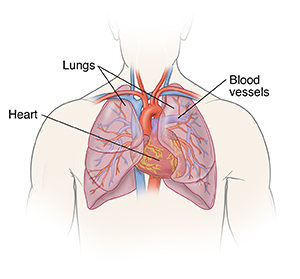Content
Pulmonary Hypertension
Pulmonary hypertension is high pressure in the blood vessels that carry blood into the lungs. This strains the lungs and heart. It can lead to serious problems.
High blood pressure
Systemic hypertension means the pressure is too high in blood vessels all throughout the body. A person with pulmonary hypertension may also have high blood pressure throughout the body.
What causes pulmonary hypertension?
The cause is sometimes not known. But it's most often caused by another health problem. In many cases, controlling this problem can help prevent or control pulmonary hypertension. Some of the most common causes of pulmonary hypertension are below.
In children:
Severe lung problems in a newborn
Lung conditions, such as cystic fibrosis or interstitial lung disease
Congenital heart defects
Other conditions, such as scleroderma, lupus, or sickle cell disease
Genetic disease
In adults:
Lung conditions, such as chronic obstructive pulmonary disease (COPD), advanced bronchitis, cystic fibrosis, or pulmonary fibrosis
Liver disease
Blood clots in the lungs
Left-sided heart failure
Sleep apnea
Other conditions, such as scleroderma, lupus, or sickle cell disease
Some medicines
Genetic disease
What are the symptoms of pulmonary hypertension?
Symptoms may come on suddenly. Or they may come on slowly over time. Symptoms can include:
Shortness of breath.
Blue lips or fingernails (signs of low oxygen).
Tiring quickly, especially when active.
Fast heartbeat.
Pain in the upper right side of the abdomen.
Nausea and vomiting.
Swelling in the legs or ankles.
Chest pain or pressure.
Fainting or dizzy spells.
Coughing that is dry or produces blood.
How is pulmonary hypertension diagnosed?
Your health care provider will give you an exam. They will listen to your heart and lungs. They will measure your blood pressure. You may have tests such as:
Blood tests. These measure certain body functions. They also check for problems such as infection.
Chest X-ray. This takes a picture of the inside of the chest. It can show some heart and lung problems.
Electrocardiogram (ECG). This test records the heart’s electrical activity.
Echocardiogram (echo). This test uses sound waves to create a moving picture of the heart.
Pulmonary function tests. These tests measure breathing and lung capacity.
Perfusion lung scan. This scan may be used to find changes in the arteries that lead to the lungs. It can show blood flow inside the lungs. And it can show blood clots.
CT scan of the chest. This test takes detailed pictures of the lungs.
6-minute walk test. This test measures your exercise tolerance. It checks if your oxygen levels drop when you exert yourself.
Cardiac catheterization (cath). This procedure measures pressures in the heart and lungs. It’s the only test that measures the pressure inside the pulmonary arteries. A thin tube (catheter) is put into a blood vessel in the groin or neck. It's guided into the right side of the heart and to the pulmonary artery. This is the main artery that sends blood to your lungs. Blood pressure tests are then done.
How is pulmonary hypertension treated?
Treatment depends on your age, health, and how bad your symptoms are. Any underlying health problems you have will be treated. Treatment may also include:
Oxygen.
Medicine to lower the pressure in the lung blood vessels.
Medicine to help the body lose excess water.
Medicine to prevent blood clots.
Medicine that helps the heart beat stronger, pump more blood, and control abnormal heart rhythms.
What are the long-term concerns?
Pulmonary hypertension has no cure. But some treatments may relieve symptoms and slow the progression of the disease. In rare and severe cases, a lung transplant may be needed. Your provider can tell you more about this if needed.
When to contact your doctor
contact your provider right away if you have any of these:
Blueness of lips, fingernails, or earlobes.
Shortness of breath.
Dizziness or lightheadedness.
Headache.
Fever of
100.4 ° F (38.0 °C ) or higher or as advised by your provider.New or unusual swelling of the legs or feet.
Symptoms that get worse.
New symptoms.
Call 911
Call
You have chest pain.
You have trouble breathing or worsening shortness of breath.
You faint.
You cough up blood.
You have a fast or irregular heart rate.


